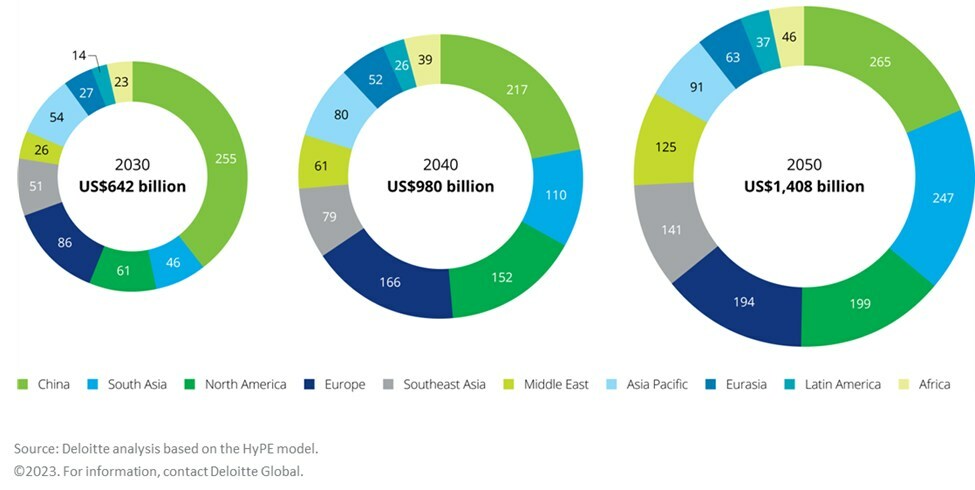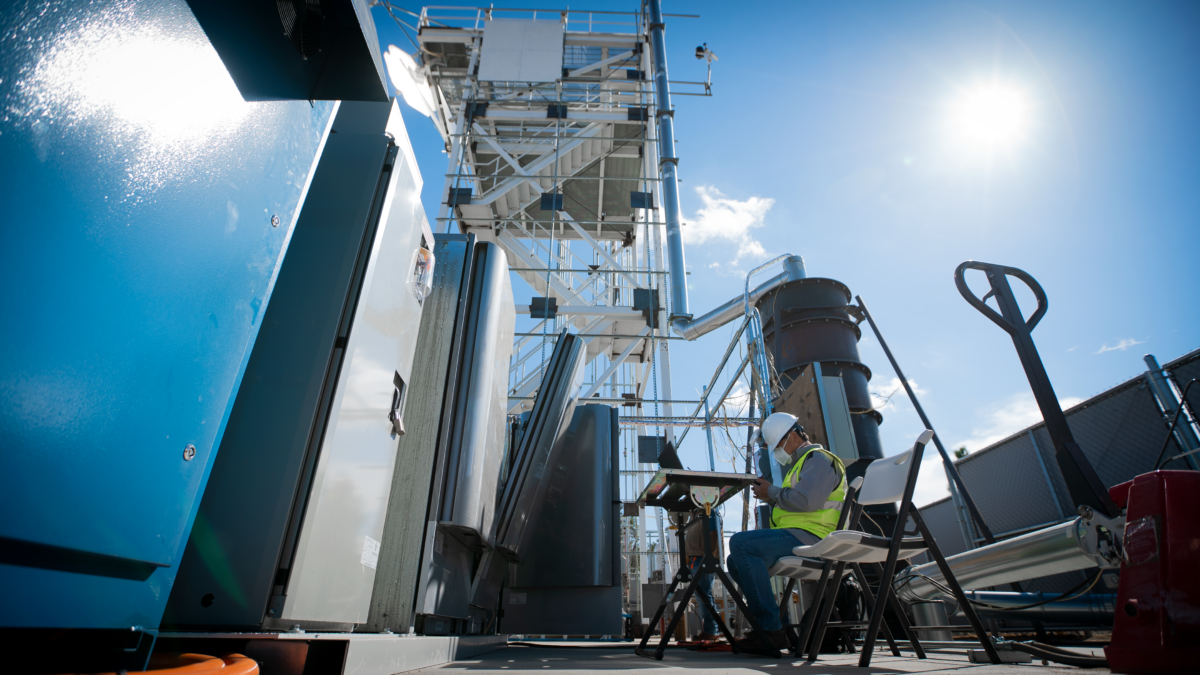A report from the Deloitte Center for Sustainable Progress (DCSP) outlined the potential of green hydrogen, or hydrogen fuel produced by renewable energy sources, to meet the demands of heavy industry.
The report set global market milestones of $642 billion by 2030, $980 billion by 2040, and $1.4 trillion by 2050, with growth in the industry split among the major global economies relatively evenly by mid-century, as seen below. This level of investment would represent a cumulative $9 trillion push by the global economy by 2050.

Hard-to-abate sectors like steelmaking, chemical manufacturing, aviation and global shipping require high amounts of energy dispatch, something that can be difficult for electrochemical batteries to achieve. While batteries may serve mobile devices, electric vehicles, and grid-scale energy storage, hydrogen may present a viable path forward for decarbonizing these high-dispatch use cases.
The report said that these sectors may drive hydrogen demand and use six-fold by 2050, leading to nearly 600 million tons of hydrogen fuel use. While hydrogen electrolysis requires large amounts of electricity, the only byproduct of burning hydrogen fuel is water, making it an emissions-free source when created by renewable sources.
However, based on current green hydrogen project announcements, the global community could only provide a collective production capacity to meet one quarter of the projected demand in 2030, said Deloitte.
The firm estimates that green hydrogen could abate 85 gigatons of cumulative emissions by 2050, which equates to more than twice the annual total emissions in the year 2021.
Deloitte said that decisive climate action can help push the competitiveness of green hydrogen. After about 10 years, green hydrogen can become cost-competitive, said Deloitte, leading to the creation of 2 million jobs per year between 2030 and 2050. The firm said that as much as 70% of this job growth could occur in developing countries.
“Money is not the problem—though the average annual investment over the time period is significantly less than the $417 billion that was spent on oil and gas production in 2022 globally,” said Prof. Dr. Bernhard Lorentz, founding chair of the DCSP. “It’s just a question of redirecting the investment to clean energy sources, and Deloitte sees that the global finance industry has an increasing appetite for major investments.”
The projections come from Deloitte’s Hydrogen Pathway Explorer (HyPE) model, which delivers analysis of the global hydrogen supply. Deloitte’s outlook provides extensive detail into the cost, production, and market of hydrogen, even analyzing the business challenges facing the successful implementation of clean hydrogen, and providing insights into various market dynamics, such as optimal infrastructure sizing, investment needs, and technology choices.
“This analysis reveals a compelling opportunity for private and public leaders to accelerate the green energy transition,” said Joe Ucuzoglu, global chief executive officer, Deloitte. “While wind, solar, and other more traditional forms of renewable power are essential to a net-zero future, Deloitte’s research demonstrates how clean hydrogen can help tackle decarbonization of some of the world’s most emissions intensive and hardest-to-abate sectors, further mitigating the effects of climate change while fueling economic growth, particularly in developing countries.”
Deloitte notes that interregional trade and diversified transport infrastructure may be a large driver in green hydrogen development adoption.
“Regions that are currently able to produce cost-competitive hydrogen in quantities that exceed domestic needs are already positioning themselves as future hydrogen exporters—supplying other less-competitive regions and helping to smoothly facilitate the energy transition,” said the report.
Notably, interregional hydrogen trade is projected to generate more than $280 billion in annual export revenues by 2050.
Deloitte has undergone some recent actions to support green hydrogen adoption, including the establishment of a Hydrogen Investment Corridor initiative to help establish multilateral collaboration across key hydrogen trade and investment pathways, with an initial focus on Germany, Australia, Africa, and Japan.
The firm also launched the Deloitte Global Hydrogen Center of Excellence, which helps hydrogen developers scale up their businesses through advisory, implementation, and operational guidance services.
This content is protected by copyright and may not be reused. If you want to cooperate with us and would like to reuse some of our content, please contact: editors@pv-magazine.com.









A green hydrogen market of $1.4 trillion is actually a conservative estimate. Why? Because there is important work underway to replace the expensive iridium with the cheap cobalt in our efficient proton exchange membrane electrolyzers:
“The team deciphered critical structural changes that occur in the catalyst under operating condition by using X-ray analyses at the Advanced Photon Source at Argonne. They also identified key catalyst features using electron microscopy … In addition, computational modeling at Berkeley Lab revealed important insights into the catalyst’s durability under reaction conditions.”
https://news.uchicago.edu/story/argonne-uchicago-scientists-create-low-cost-way-make-clean-hydrogen-fuel
Deloitte predicts exponential growth as the green hydrogen market is expected to surge to a staggering $1.4 trillion, reflecting the immense potential and lucrative opportunities in the clean energy sector.